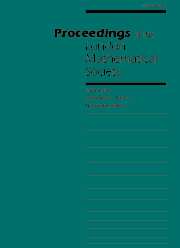Article contents
SPARSE PARTITION REGULARITY
Published online by Cambridge University Press: 13 October 2006
Abstract
Our aim in this paper is to prove Deuber's conjecture on sparse partition regularity, that for every $m$, $p$ and $c$ there exists a subset of the natural numbers whose $(m,p,c)$-sets have high girth and chromatic number. More precisely, we show that for any $m$, $p$, $c$, $k$ and $g$ there is a subset $S$ of the natural numbers that is sufficiently rich in $(m,p,c)$-sets that whenever $S$ is $k$-coloured there is a monochromatic $(m,p,c)$-set, yet is so sparse that its $(m,p,c)$-sets do not form any cycles of length less than $g$.
Our main tools are some extensions of Nešetřil–Rödl amalgamation and a Ramsey theorem of Bergelson, Hindman and Leader. As a sideline, we obtain a Ramsey theorem for products of trees that may be of independent interest.
Keywords
Information
- Type
- Research Article
- Information
- Proceedings of the London Mathematical Society , Volume 93 , Issue 3 , November 2006 , pp. 545 - 569
- Copyright
- 2006 London Mathematical Society
- 1
- Cited by

